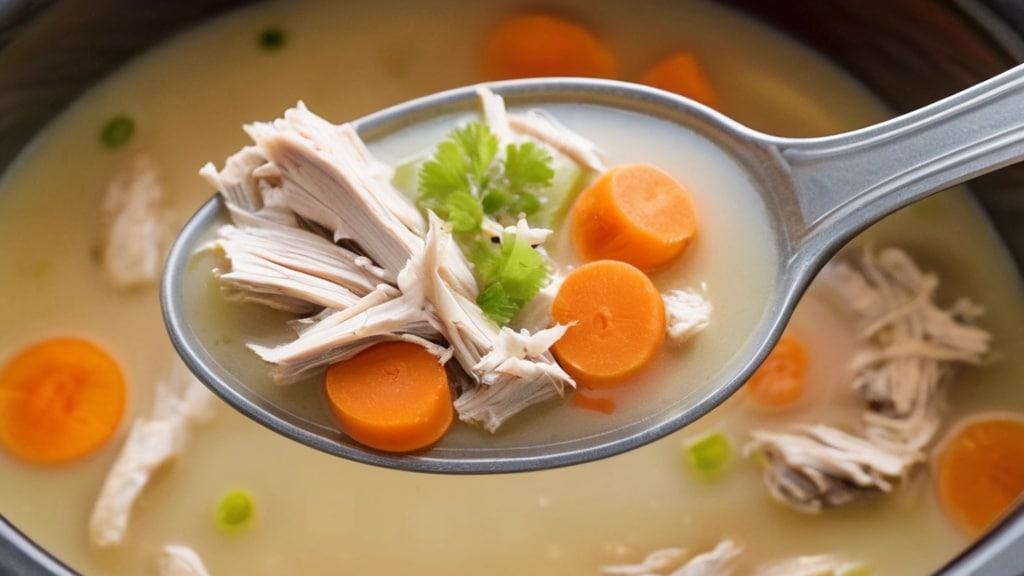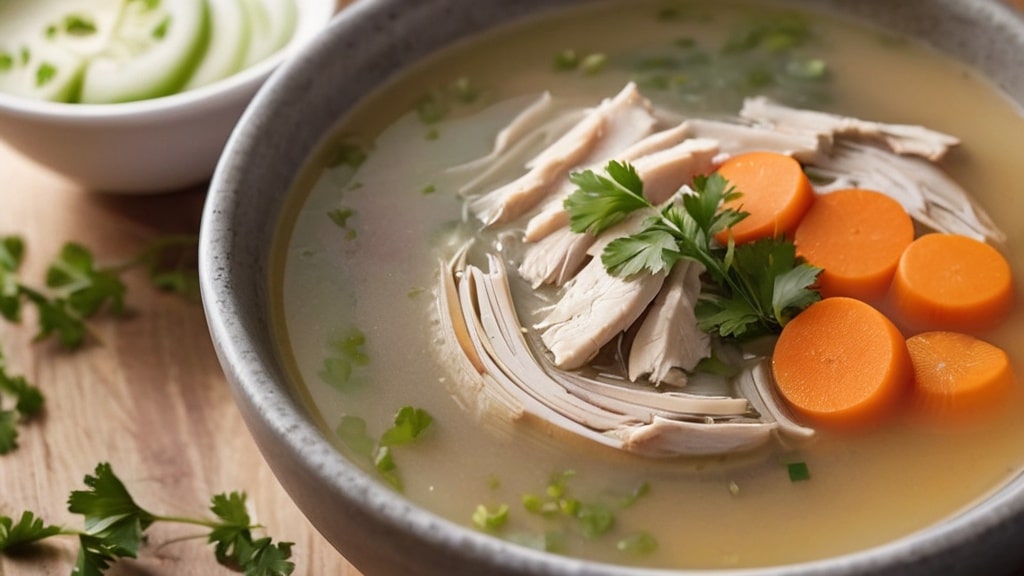I still remember the day my kitchen philosophy changed forever. There I was, battling a nasty winter cold, desperately searching for something nourishing that wouldn’t require me to stand at the stove for hours. That’s when this ridiculously simple 5-ingredient chicken soup saved me. And lemme tell ya sometimes the most profound culinary revelations come from necessity rather than fancy technique.
When life gets chaotic but your body craves real nutrition, this paleo-friendly chicken soup delivers serious flavor without the fuss. Its beauty lies in its simplicity just five clean ingredients that transform into a deeply nourishing meal while you’re off living your life. No processed ingredients, no dairy, no grains just pure, clean comfort that aligns perfectly with paleo principles without sacrificing an ounce of satisfaction.
Ingredients & Substitutions
The Core Five
- 2 pounds bone-in, skin-on chicken thighs (preferably organic/free-range)
- 4 cups organic chicken bone broth (homemade preferred, but high-quality store-bought works)
- 1 large yellow onion, roughly chopped
- 3 large carrots, cut into 1-inch chunks
- 2 tablespoons fresh herbs (rosemary, thyme, and sage combo recommended)
Optional Add-ins
- 1-2 cups leafy greens (kale, spinach, or swiss chard)
- 1 tablespoon apple cider vinegar (helps extract nutrients from bones)
- 2-3 garlic cloves, smashed
- 1 teaspoon sea salt (adjust to taste)
- ½ teaspoon freshly ground black pepper
Smart Substitutions
Can’t find bone-in thighs? Drumsticks provide similar richness, though I’d avoid breast meat it simply doesn’t deliver the same depth of flavor or texture in slow cooking. If your avoiding chicken entirely, turkey legs make a fantastic alternative with there own unique mineral profile.
Store-bought bone broth varies wildly in quality. Look for brands with visible gelatin when cold that’s the good stuff packed with collagen. Vegans can substitute mushroom broth enhanced with a touch of coconut aminos, though this substantially alters the flavor profile and nutritional benefits.
For the herbally challenged, a tablespoon of Italian herb blend works in a pinch, tho fresh herbs truly elevate this simple dish to something special. The volatile oils in fresh herbs release slowly during extended cooking, infusing the broth with complex aromatics that dried simply cannot match.
Step-by-Step Instructions

Preparation (5 minutes)
- Trim any excess fat from chicken thighs, but leave skin on it contributes valuable nutrients and richness to the broth. Pat dry with paper towels to remove excess moisture, which improves browning if your opting for the optional searing step.
- Roughly chop onion and carrots into large chunks. Don’t bother with precise knife work here; rustic cuts actually work better for long cooking processes. Plus, who’s got time for fancy julienne when your feeling under the weather?
- Strip herb leaves from woody stems and roughly chop. The stems can be tossed into the pot whole for extra flavor—just remember to fish them out before serving.
Optional Searing (10 minutes)
While not strictly necessary, quickly searing the chicken before adding it to the crockpot dramatically enhances flavor through the Maillard reaction. Heat a tablespoon of avocado oil in a heavy skillet over medium-high heat. Place chicken skin-side down and cook undisturbed for 3-4 minutes until golden. This step creates those complex flavor compounds that make the difference between good soup and exceptional soup.
Slow Cooking (4-8 hours)
- Layer ingredients in your crockpot: onions on the bottom (they’ll release moisture that prevents sticking), followed by carrots, chicken (skin side up), and herbs scattered over top. This layering technique ensures even cooking and optimal flavor development.
- Pour broth over everything, making sure chicken is mostly submerged. Add apple cider vinegar now if using—it helps extract minerals from the bones during the long cooking process. A frequently overlooked step that significantly increases the nutritional value.
- Cover and cook on low for 6-8 hours or high for 4 hours. Avoid lifting the lid during cooking, as this releases accumulated heat and extends cooking time. The soup is ready when chicken easily falls off the bone and vegetables are tender but not mushy.
Finishing Touches (5 minutes)
- Remove chicken pieces and place on a cutting board. When cool enough to handle, discard skin and bones, then shred meat with two forks. Return meat to the pot.
- If using leafy greens, add them now and stir until just wilted about 2-3 minutes. Season with salt and pepper to taste. Remember that flavors concentrate as soup sits, so slight under-seasoning isn’t the worst strategy.
- Allow soup to rest for 10 minutes before serving. This resting period allows flavors to fully meld and integrate, just like with a good steak or braise. Trust me on this one patience pays delicious dividends.
Cooking Techniques & Science
The Magic of Low & Slow
The genius of crockpot cooking lies in its gentle, prolonged heat application. This slow-cooking method gradually breaks down the collagen in chicken connective tissues, converting it to gelatin which creates that silky, rich mouthfeel we associate with homemade soup. Your not just making dinner; your extracting precious nutrients that require time to release.
In contrast to aggressive boiling which can toughen proteins, the low simmer of a crockpot ensures tender meat that practically melts in your mouth. The technical term for this process is “denaturation” proteins literally changing their structure in response to heat, becoming more digestible and bioavailable in the process.
The humble onion undergoes a fascinating transformation during extended cooking. Its sharp, pungent compounds slowly convert to natural sugars through caramelization, adding subtle sweetness that balances the savory elements without any added sweeteners. This aligns perfectly with paleo principles while delivering remarkable depth.
Bone-In vs. Boneless

Using bone-in chicken isn’t just about flavor it’s about nutrition. Bones contain minerals like calcium, magnesium, and phosphorus that leach into the broth during cooking. The marrow inside bones contributes immune-supporting compounds and essential fatty acids.
The skin contributes collagen (which converts to gelatin) along with fat-soluble vitamins A, D, E, and K. These nutrients aren’t just filler—they’re fundamental building blocks your body needs, especially when fighting illness or recovering from stress. While modern nutrition often demonizes animal fats, ancestral wisdom recognized there valuable role in overall health.
Aromatics & Layering
Aromatics like onions serve multiple purposes in soup building. Beyond flavor, they create a protective buffer at the bottom of the crockpot, preventing other ingredients from sticking or burning. Their high water content releases during cooking, contributing additional liquid to the broth.
Herbs added at the beginning of cooking versus the end produce entirely different flavor profiles. Early addition allows more complete integration but sacrifices the brighter notes that characterize fresh herbs. For the best of both worlds, reserve a small portion of your herbs to add in the final minutes of cooking.
Serving & Pairing Suggestions
Presentation
For maximum visual impact, serve this rustic soup in wide, shallow bowls that showcase the vibrant carrots and tender chicken pieces. A small scatter of fresh herbs preferably the same varieties used in cooking adds color contrast and aromatic freshness that signals quality to diners before they even taste.
Consider keeping larger pieces of carrot intact rather than mashing or puréeing. The varied textures of tender meat, silky broth, and toothsome vegetables create a more satisfying eating experience than uniform consistency. Sometimes the most appealing presentations embrace rusticity rather than fighting it.
For meal prep purposes, this soup actually improves with age (within reason). Store portioned containers in the refrigerator for up to 4 days, or freeze for up to 3 months. The gelatin-rich broth will solidify when cold a sign of quality that liquefies again upon gentle reheating.
Complementary Pairings
Although traditional bread accompaniments aren’t paleo-compliant, there are excellent alternatives. Serve alongside roasted sweet potato rounds or grain-free “flatbread” made from almond and tapioca flours. These starchy companions balance the protein-rich soup perfectly.
For added vegetable power, consider a simple side salad of bitter greens dressed with lemon juice and olive oil. The acidic brightness cuts through the richness of the broth, cleansing the palate between spoonfuls. This contrast follows classical culinary principles of balance despite staying firmly within paleo parameters.
Beverage pairings might include sparkling water with citrus, kombucha, or herbal teas. If alcohol is part of your lifestyle, a light-bodied pinot noir or unfiltered natural cider complements without overwhelming the delicate flavors. Always consider the context—recovery meals might skip alcohol altogether in favor of anti-inflammatory options.
Storage & Reheating Tips
This soup maintains its quality remarkably well during storage, often developing even deeper flavor after a day in the refrigerator. Store in glass containers rather than plastic to prevent leaching and off-flavors. Always cool completely before refrigerating to prevent bacterial growth and textural issues.
When reheating, gentle methods preserve quality best. Low heat on the stovetop with occasional stirring prevents the chicken from toughening or vegetables from breaking down further. Microwaving works in a pinch but increases the risk of uneven heating and textural damage.
For frozen portions, thaw overnight in the refrigerator rather than using defrost settings, which can partially cook edges while the center remains frozen. Add a small splash of fresh bone broth when reheating to refresh flavors and restore original consistency. This professional restaurateur trick makes leftovers taste nearly identical to fresh-made.
Conclusion
The beauty of this 5-ingredient paleo chicken soup lies not just in its simplicity but in its ability to deliver profound nourishment when you need it most. By leveraging slow-cooking techniques and quality ingredients, you’ve created something that transcends the sum of its parts transforming humble components into liquid gold.
Remember that simplicity in cooking isn’t about cutting corners; it’s about having the confidence to let quality ingredients shine through minimal interference. This approach aligns perfectly with both professional culinary philosophy and ancestral nutrition principles, proving that sometimes the most sophisticated cooking is also the most elemental.
Whether you’re cooking for restoration, daily nourishment, or preventative health, this recipe deserves a permanent place in your culinary repertoire. Its adaptability to seasonal ingredients and individual needs makes it less a fixed recipe and more a framework for creative, health-conscious cooking that never sacrifices satisfaction on the altar of nutrition.
FAQs
Can I use chicken breasts instead of thighs?
While technically possible, boneless skinless chicken breasts lack the fat, collagen, and flavor compounds that make this soup special. They also tend to dry out during extended cooking. If white meat is a must, consider a hybrid approach—use 1 pound of bone-in thighs for the broth’s foundation, then add breast meat during the final hour of cooking.
Why isn’t my broth gelatinous like you described?
The gelatin content depends primarily on three factors: the quality of chicken parts used, cooking duration, and the ratio of water to bones. Farm-raised, pastured chickens typically produce more gelatin than conventional ones. Ensure sufficient cooking time (minimum 6 hours on low) and don’t overdo the liquid component. Adding 1-2 chicken feet to your crockpot while admittedly not the most appealing ingredient dramatically increases gelatin formation.
How can I make this soup more filling while keeping it paleo?
For added satiety without compromising paleo principles, consider increasing protein by adding a second type of meat (like pastured pork or grass-fed beef cubes). Alternatively, boost fiber and healthy fats with diced avocado added at serving time, or incorporate more root vegetables like turnips, parsnips, or celery root. Cauliflower rice added during the final 15 minutes of cooking absorbs flavors while adding bulk and fiber.
My family doesn’t follow paleo how can I adapt this for them?
The beauty of this recipe is its adaptability. For non-paleo eaters, simply serve with quality sourdough bread, cooked rice, or egg noodles added to individual portions rather than the communal pot. This preserves the paleo version for those who want it while satisfying different dietary preferences. You might also incorporate white potatoes or corn, which are excluded from strict paleo approaches but perfectly wholesome for most people.
Can this recipe be adapted for vegetarians while maintaining its nutritional benefits?
Creating a vegetarian version requires significant modification. Replace chicken with extra-firm tofu or tempeh added during the final hour of cooking (early addition causes disintegration). Use mushroom broth enhanced with dried porcini powder and coconut aminos for umami depth. Nutritional yeast provides B-vitamins typically obtained from animal products. While delicious in its own right, this adaptation creates a fundamentally different dish with altered nutritional properties.

